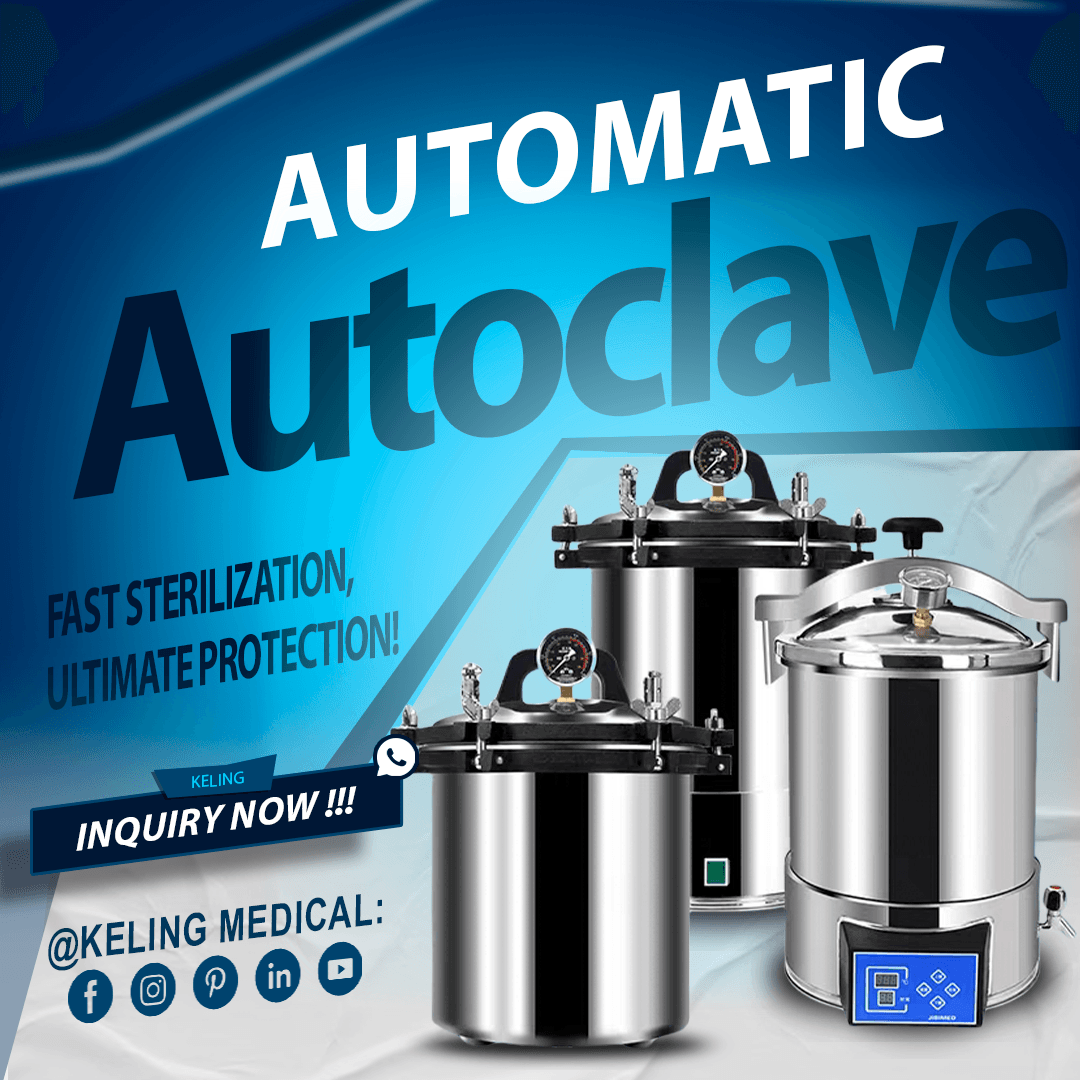
의료 장비 유통업체, 딜러 및 조달 전문가의 경우 다음을 이해해야 합니다. 오토클레이브의 사용 용도 는 의료, 실험실, 산업 및 상업 환경의 고객에게 적합한 솔루션을 추천하고 공급하는 데 있어 매우 중요합니다. 이 가이드에서는 오토클레이브의 다양한 용도와 응용 분야를 살펴보고 모든 요구 사항에 적합한 장비를 선택하는 데 필요한 실질적인 통찰력을 제공합니다.
오토클레이브는 규제 요건을 충족하는 멸균을 통해 환자의 안전을 유지하는 데 도움이 되기 때문에 의료 환경에서 중요한 역할을 합니다.
오토클레이브는 의료 시설에서 수술 도구를 멸균하기 위해 일반적으로 사용됩니다. 의료 시술 중에는 메스, 겸자, 가위, 클램프, 견인기 등이 혈액 조직 및 체액과 접촉하게 됩니다. 오토클레이브는 수술 기구를 재사용하기 전에 박테리아, 바이러스, 곰팡이, 포자 등을 모두 제거하여 수술 부위 감염 가능성을 낮추고 교차 오염을 방지합니다.
오토클레이브를 사용하면 여러 수술 기구를 한 번에 빠르고 효율적으로 처리할 수 있습니다.
기구의 멸균은 시설 프로토콜에 따라 포장된 형태와 포장되지 않은 형태 모두에 적용할 수 있습니다.
고압 스팀이 복잡한 기구와 경첩이 달린 장치까지 깊숙이 침투하여 완벽한 살균을 실현합니다.
병원에서는 사용한 붕대, 장갑, 가운, 일회용 기구 등 감염 가능성이 있는 다양한 폐기물이 대량으로 발생합니다. 의료 폐기물은 폐기 전에 오토클레이브를 통해 멸균 처리하여 안전하고 감염성이 없는 상태로 만듭니다.
의료 폐기물을 고압 멸균 처리하면 환경 오염과 질병 확산의 가능성을 줄일 수 있습니다.
이 절차는 현지 및 글로벌 폐기물 관리 표준의 모든 요구 사항을 충족합니다.
지속 가능하고 책임감 있는 의료 서비스 운영을 지원합니다.
연구 및 진단 실험실은 실험실 직원의 안전을 보장하면서 정확한 결과를 도출하는 데 필요한 멸균 환경을 조성하기 위해 오토클레이브에 의존합니다.
오토클레이브는 연구 환경에서 배지 및 장비와 함께 실험실 유리 제품을 멸균하는 필수 도구로 사용됩니다. 비커, 플라스크, 시험관, 배양 배지, 피펫 등 모든 실험실 장비는 신뢰할 수 있는 실험 결과를 보장하기 위해 오염 물질이 없는 상태를 유지해야 합니다.
오토클레이브는 배양 및 실험의 오염을 방지합니다.
재사용 가능한 실험실 도구를 살균하는 데 적합합니다.
실험실 안전 표준을 준수하는 데 필수적입니다.
미생물학 실험실에서는 병원성 미생물을 자주 취급합니다. 오염된 물질 및 배양 배지와 함께 생물학적 위험 폐기물을 오토클레이브를 통해 멸균하여 유해 물질이 우발적으로 방출되는 것을 방지합니다.
위험한 병원균을 비활성화하여 생물학적 안전성을 보장합니다.
감염성 폐기물을 안전하게 처리할 수 있습니다.
생물학적 안전 규정 및 표준을 준수하려면 이 요구 사항이 필요합니다.
오토클레이브는 의료 및 실험실 환경 외에도 다양한 산업 및 상업적 용도로 사용됩니다.
식품 업계에서는 레토르트라고 하는 오토클레이브를 사용하여 통조림 식품과 음료를 살균합니다. 살균 절차는 부패를 유발하는 미생물을 제거하여 식품 보관 수명을 연장하고 소비에 대한 안전성을 보장합니다.
오토클레이브는 야채, 육류 및 유제품을 포함한 저산성 식품을 살균합니다.
식품 안전 규정을 준수합니다.
소비자를 위한 제품 품질과 안전성을 유지합니다.
문신 시술실, 피어싱 스튜디오, 미용실의 오토클레이브는 바늘, 집게, 가위 등 재사용 가능한 기구를 살균하는 용도로 사용됩니다. 오토클레이브는 의료 기구를 적절히 살균하여 간염과 HIV 감염을 예방하는 데 도움이 됩니다.
고객 안전 및 규정 준수에 필수적입니다.
위생에 대한 전문성과 헌신을 보여줍니다.
퍼스널 케어 비즈니스는 오토클레이브 멸균 관행을 통해 고객 사이에서 신뢰와 좋은 평판을 구축하고 유지할 수 있습니다.
오토클레이브의 선택은 용적 및 규제 표준과 함께 애플리케이션 요구 사항을 기반으로 해야 합니다. 다음은 고려해야 할 주요 요소입니다:
솔리드 인스트루먼트: 표준 오토클레이브가 적합합니다.
액체 부하는 끓는 것을 방지하기 위해 특정 오토클레이브 사이클이 필요합니다.
다공성 하중을 통한 효과적인 증기 침투를 위해서는 진공 보조 오토클레이브를 사용해야 합니다.
각 오토클레이브 주기 동안 멸균이 필요한 품목의 수를 평가합니다.
시설의 운영 요구사항에 맞는 챔버 크기를 선택하세요.
오늘날의 오토클레이브는 프로그래밍 가능한 주기 및 데이터 로깅 기능과 함께 출력물을 제공하여 규제 요건을 충족합니다.
최적의 안전을 위해 오토클레이브에 압력 방출 메커니즘과 도어 인터록 시스템, 자동 차단 기능이 있는지 확인하세요.
일상적인 유지보수를 용이하게 하고 신뢰할 수 있는 기술 지원을 보장하는 액세스 권한을 제공하세요.
오토클레이브가 모든 관련 지역, 국가 및 국제 산업 표준을 충족하는지 확인하세요.
이해 오토클레이브의 사용 용도 는 의료 및 실험실 장비의 유통, 조달 또는 사용에 관여하는 모든 사람에게 필수적입니다. 오토클레이브는 의료, 실험실, 산업 및 상업 환경에서 멸균을 위한 다목적, 신뢰성, 필수 불가결한 도구입니다. 공중 보건을 보호하고 규정을 준수하며 안전하고 효율적인 운영을 지원합니다.
유통업체와 조달 전문가에게 있어 고객의 요구에 적합한 오토클레이브를 매칭하는 것은 전문성과 고품질 서비스의 상징입니다. 최신 정보를 파악하고, 안전을 우선시하며, 신뢰할 수 있는 제조업체와 협력하여 모든 애플리케이션에 가장 적합한 솔루션을 제공하세요.
병원에서 오토클레이브는 주로 수술 기구, 의료 기기, 병원 폐기물을 멸균하여 감염을 예방하고 환자의 안전을 보장하는 데 사용됩니다.
유리 제품, 배양 배지, 생물학적 위험 폐기물을 멸균하여 정확한 연구와 진단을 위해 오염 없는 환경을 유지합니다.
예, 오토클레이브(레토르트)는 식품 산업에서 통조림 식품 및 음료를 살균하여 제품의 안전성과 수명을 보장하는 데 널리 사용됩니다.
부하 유형, 용량, 제어 기능, 안전 메커니즘, 유지보수 필요성, 업계 표준 준수 여부 등을 고려하세요.
물론입니다. 오토클레이브는 재사용 가능한 도구를 살균하고, 고객을 감염으로부터 보호하며, 보건 규정을 준수하는 데 필수적입니다.
다음을 참조하세요. 오토클레이브의 기능은 무엇인가요? 그리고 오토클레이브를 안전하게 사용하는 방법 를 클릭해 자세한 가이드를 확인하세요.
고객을 위한 신뢰할 수 있는 오토클레이브 솔루션을 찾고 있는 유통업체, 딜러 또는 조달 전문가이신가요? 연락처 켈링 메디컬 전문가의 조언과 프리미엄 오토클레이브 장비에 대해 알아보세요!
이메일: inquiry@shkeling.com
WhatsApp: +8618221822482
저희 팀은 업계 최고의 제품과 전문적인 가이드로 여러분의 비즈니스를 지원할 준비가 되어 있습니다. 지금 바로 문의하여 필요한 사항을 논의하세요!

Introduction Autoclave machines used in hospitals are one of the most important investments in healthcare infrastructure, serving as the first line of defense against healthcare-associated infections. Sophisticated sterilization equipment is

오토클레이브 공정은 의료, 실험실 및 연구 시설에서 효과적인 멸균을 통해 유리 제품과 기구를 보호하기 위해 사용하는 필수 멸균 방식입니다. 고압 증기는 이 과정에서 병원균을 제거합니다.

오토클레이브 공정은 의료, 실험실 및 연구 시설에서 효과적인 멸균을 통해 유리 제품과 기구를 보호하기 위해 사용하는 필수 멸균 방식입니다. 고압 증기는 이 과정에서 병원균을 제거합니다.

오토클레이브 공정은 의료, 실험실 및 연구 시설에서 효과적인 멸균을 통해 유리 제품과 기구를 보호하기 위해 사용하는 필수 멸균 방식입니다. 고압 증기는 이 과정에서 병원균을 제거합니다.